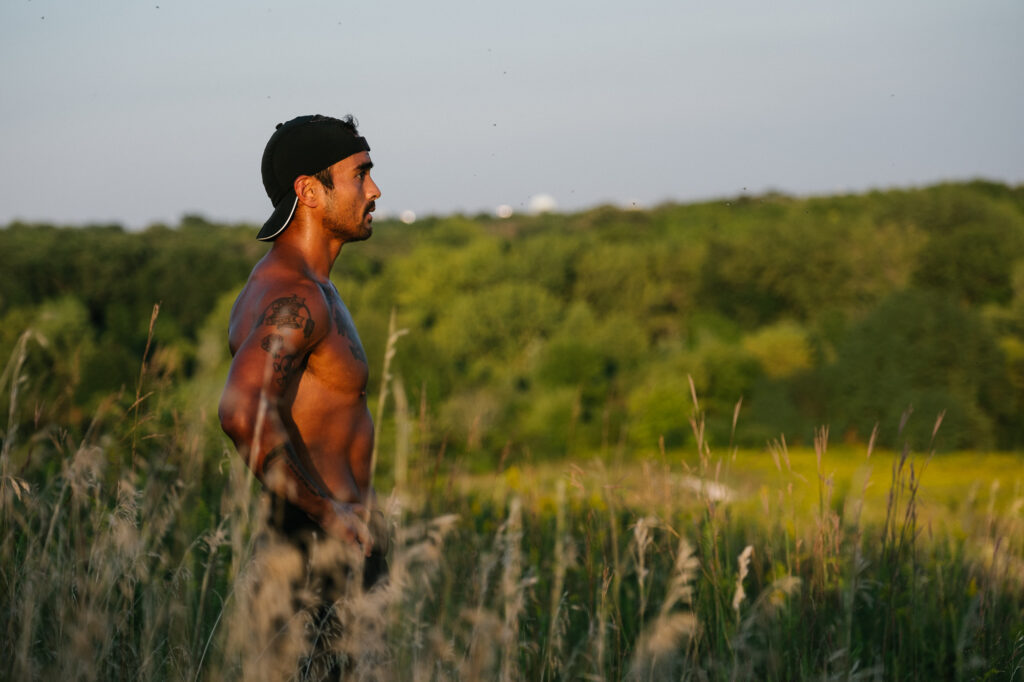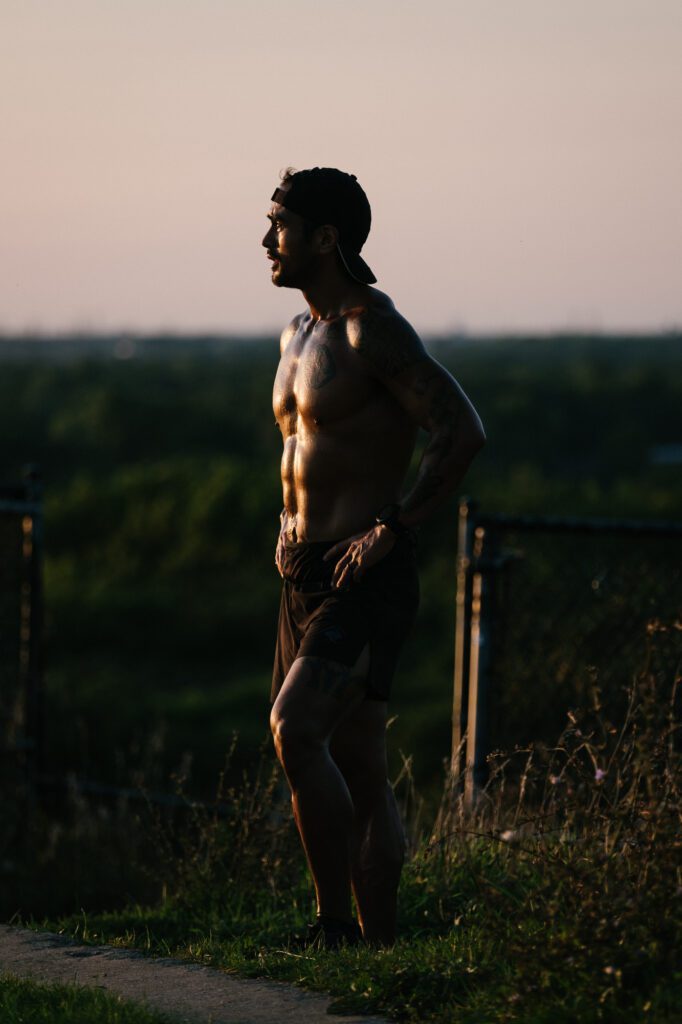

Photos by Tim Roberts
James Solomon pulls into a small, crushed gravel parking area and hooks a gentle left, sweeping his headlights across a sprawling electrical substation set back in the shadows, before coming to stop. Shifting into park, he kills the engine and peers through the windshield at the ambient red sheen of a traffic light bleeding out over Winfield Road. He sits for a moment, long enough for the clear night sky to define itself beyond the glass. The darkness here is near complete. Minor stars glimmer faintly to the east, speckled just above a distant line of black trees, barely visible like subtle variations in a shadow.
Stepping out of the car, James checks his Garmin. From here, he’ll run a mile into the park to Mt. Hoy, where his training will begin in earnest with hill repeats. This is what you do when you’re chasing a record—even when that record is one you already own—you get up before dawn and run.
Ready, James starts his watch and runs into the darkness.

* * *
Hard Prairie: What time do you wake up every morning?
James Solomon: I usually get up around 2:30 a.m. and start running around 3:30 a.m. or 4 a.m.
HP: Do you stretch?
James: No. I’ll do a little percussion therapy with a Theragun and wrap some Voodoo Floss on my ankles and calves, but no stretching.
HP: And you usually run ten miles in the morning, is that right?
James: At least, yeah.
HP: And your nights end pretty early, like 6 or 7 o’clock?
James: Yeah, that’s correct.
HP: But you also run during your lunch hour, right?
James: That’s correct. That’s like my speed work. By the time lunch comes, my legs are warmed up. I can reach a faster pace sooner than in the morning. Plus, all my morning workout are fasted.
HP: So you don’t eat in the morning or drink coffee?
James: No.
HP: You don’t use any caffeine?
James: No.
HP: Are you vegan or vegetarian?
James: I would say I’m vegan. I’ll celebrate with pizza that has real cheese; however, the majority of my lifestyle is vegan.
HP: So you don’t consume much sugar either?
James: Not really. For breakfast sometimes I’ll have oatmeal with blue agave in it. And I don’t skimp on the agave.
HP: And, after work, you don’t ever run?
James: Not typically, no.
* * *

Uncomfortable, but not insufferable. Not wanting to draw attention from park rangers or passing cops, James forgoes a headlamp, choosing instead to run by sense memory and instinct. Beneath him, the path unfurls like a slender tributary of pale, lusterless mercury—the crushed gravel glowing a muted silver in the dark. Off to his right, moonlight dapples the glassy surface of a lake. Along the shore, bullfrogs bellow over the chirp of katydids and June bugs. Somewhere in the underbrush a twigs snaps and a small mammal panics through the thicket.
James never breaks stride.
Last year’s Cry Me A River (CMAR ) plays on a loop in his head. He won the Peoria-based 100-mile ultra and set a new course record; however, as he runs now, he mulls over every remembered detail. He looks for lost time in the flats and downhills and questions whether he loitered too long in Green Valley and Camp Wokanda. He envisions each climb, parsing out which hills might be feasible to run, knowing that if he plans on breaking his own record this year, running up them will be imperative.
Conquering vert is the key to conquering CMAR.
And conquering CMAR, as James knows all too well, is a big fucking deal.
* * *
Hard Prairie: At what point did you decide you wanted to go back to CMAR?
James Solomon: I really got a lot a confidence after my Kettle Moraine race this year. Plus, I had put in the training, and I wanted to teach myself that even if it’s the same race, different problems will happen. It will be a totally different experience.
HP: What was it about Kettle that gave you the confidence to come back?
James: I had a solid goal of a sub-twenty-hour finish, and I went about an hour and a half under that. I surprised myself.
HP: Going into Kettle, what was your training like?
James: I wrapped up Potawatomi in April and did my week of recovery. It was just starting to get really nice out. I was beginning to do a lot more longs runs and hills at Mt. Hoy. I usually use May as a big training month for June and July races. I put in a four-hundred-mile month in May to train up for Kettle and CMAR.
HP: When do you get it in your mind that you’re going to try and break your own CMAR record?
James: Probably my second week back into training. I took a recovery week. Then my first week back, I’m running a lot of flat stuff—but still high mileage. That second week back, I felt better than anticipated. So I began thinking about my goals for going into CMAR, and breaking my own record became my A goal.
* * *
Mt. Hoy wasn’t gouged out by glaciers or exposed through erosion, nor was it born of any grand tectonic event. In fact, it isn’t natural in any geomorphic sense at all. What it is, is a capped mountain of trash. From 1965 to 1973, this property served as the county landfill. Now it operates as Blackwell Forest Preserve, with Mt. Hoy as its most prominent feature—a seven-hundred-foot col, with a one-hundred-and-forty-foot prominence pitched at varying grades depending on which way you go up.
Coming upon Mt. Hoy’s southern base, James glances at his Garmin. He has eight miles of hill repeats ahead of him—no dogging it and no cutting corners. That shit isn’t in his blood. Veering onto the trail, he knows exactly how far he’s come and, just as importantly, exactly how far he wants to go.
* * *

Hard Prairie: What does your hill training entail?
James Solomon: Blackwell opens the gates an hour after sunrise, so I have to run into the park. I park off Winfield Rd and Butterfield. From there to the bottom of the hill is one mile. I’ll get eight miles of repeat in, then I’ll run back. I run up the steep dirt trail on the back of the hill, go halfway down a gravel path, then cut back down towards the road again. And I just repeat that, running it all without stopping.
HP: Is the majority of your hill workout done at Hoy?
James: Yeah, probably 95%. I’ll also go to Crystal Lake at Veteran Acres. They don’t have a single hill like Mt. Hoy, but it’s pretty hilly for a normal run.
HP: In a given week, as you’re building up to CMAR, what is your average mileage?
James: Between 95 and 100-plus miles.
HP: How much of that is hills?
James: Probably 20-30%.
* * *
It drips onto his calves from the saturated bill of his backwards cap. It pools in the groove between his clavicles. Every inhalation detonates in his lungs like an errant bottle rocket, the humidity wreaking havoc with his breathing. He works the hill like a machine, gutting out the miles and logging ascent after ascent. CMAR eats alive the underprepared.
James is determined to be ready.
To the east the darkness shows signs of breaking as wispy grey tendrils of light slip parallel to the horizon. Some mornings, when a run is going particularly well, there’s no notice of the gathering light. It’s just suddenly there, his sense of time all jumbled and askew.
This is not one of those mornings.
Hill days rarely are.
* * *
Hard Prairie: So, you break your own record at CMAR in July. What’s going through your mind when you cross the finish line?
James Solomon: I was super happy. But, really, I was thinking, “Fuck, yeah! This is just one step closer to a top-ten finish at Western States.” That was my honest thought. I got to pace and spectate at Western States earlier this year. I saw all these amazing runners, and I was thinking, “Why couldn’t I be Top-Ten?” So I’m going to put in the work and do the best I can. If I make, I make it. If I don’t, at least I know I put in 100% effort.
* * *
Chest heaving, he places his hands on his waist. Daybreak reflects off the smooth white bulbs of scattered water towers and the windows of office buildings. In all directions, the suburbs spread out like a bland network of rooftops and chimneys and trees. It all looks so still, so sleepy.
James, however, is wide awake.
Hill repeats are a grind—monotonous and painful. But James knows that the grind is what hardens you. It chisels away doubt and fear, clearing a path to accomplishing amazing things on a course as brutal as CMAR.
The grind is how myths are made and how records are broken.

